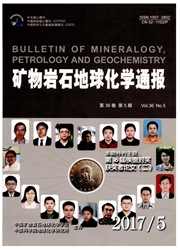

 中文摘要:
中文摘要:
本文介绍了埃达克质岩形成的构造背景与岩石组合。埃达克质岩可以形成于不同的构造背景并与不同类型的岩石同时出现:1)火山弧环境中常出现埃达克质岩一高镁安山岩-富Nb玄武质岩组合,它的形成可能与板片熔融以及熔体一地幔橄榄岩的相互作用有关;2)大陆活动碰撞造山带环境(如羌塘)中埃达克质岩常与同期钾质或橄榄玄粗质岩共生,这可能与俯冲陆壳熔融和俯冲陆壳熔体交代的地幔橄榄岩熔融有关;3)造山带伸展垮塌环境(如大别山)中埃达克质岩会伴随有镁铁质一超镁铁质岩浆出露,增厚下地壳产生埃达克质岩浆后的榴辉岩质残留体拆沉进入地幔,与地幔橄榄岩的混合可能形成后期镁铁质一超镁铁质岩浆的源区;4)大陆板内伸展环境中埃达克质岩常与同期橄榄玄粗质的岩石共生,增厚、拆沉下地壳,以及富集地幔的熔融或岩浆混合在岩石的成因中发挥了重要作用。
 英文摘要:
英文摘要:
In this paper, tectonic setting and associated rock suites of adakitic rocks are introduced. Adakitic rocks can be generated in different tectonic setting and occur together with some other types of magmatic rocks. In a volcanic arc setting, adakitic rock-high-Mg andesite-Nb-enriched basaltic rock suites often occur and are possibly derived by slab melting and the interaction between slab melt and mantle peridotites. In an active collisional orogenic belt (e. g. Qiangtang), adakitic rocks occur together with coeval potassie or shoshonitc rocks, and their petrogenesis is related to partial melting of subducted continental crust and mantle peridotites metasomatized by subducted continental crust-derived melts. In a collapsed and extensional stage of an orogenic belt (e. g. , Dabie), adakitie rocks sometimes are followed by mafic-ultramafic rocks, which possibly originated from a mixed source comprising eclogitic residue that was formed after the extraction of adakitic magma in the lower crust and mantle peridotites. In an extensional setting within a continent, some adakitic rocks are associated with coeval shoshonitic rocks, and partial melting of thickened or delaminated lower crust and enriched mantle or magmatic mixing play an important role in their petrogenesis.
 同期刊论文项目
同期刊论文项目
 同项目期刊论文
同项目期刊论文
 Partial melting of thickened or delaminated lower crust in the middle of eastern China: implications
Partial melting of thickened or delaminated lower crust in the middle of eastern China: implications Eocene melting of subducting continental crust and early uplifting of central Tibet: evidence from c
Eocene melting of subducting continental crust and early uplifting of central Tibet: evidence from c Triassic Nb-enriched basalts, magnesian andesites, and adakites of the Qiangtang terrane (Central Ti
Triassic Nb-enriched basalts, magnesian andesites, and adakites of the Qiangtang terrane (Central Ti Petrogenesis of Carboniferous adakites and Nb-enriched arc basalts in the Alataw area, northern Tian
Petrogenesis of Carboniferous adakites and Nb-enriched arc basalts in the Alataw area, northern Tian 期刊信息
期刊信息
